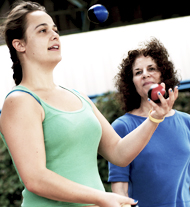Movement and learning

A passion for movement has driven Victoria Quine since she took her first dance class at the age of three. She's absorbed the techniques of modern, jazz, and ballet styles. Gymnastic routines are a joy. From performing with Hampshire's circus troupe, Circus Folk Unite, to leading the new student orientation program "Circus for the Gravitationally Challenged," she's constantly dreaming up new routines and approaches both individually and with collaborators.
 |
"Dance is important to my soul, so I've enjoyed my classes with Becky," she says. "The technical stuff on learning and education and the brain, Jane knows all about this. Having both of them on my committee was exactly what I needed, and I've gotten a wide range of support and really good feedback."
For Quine's Division III (senior) project, Everything I Need to Know I Learned in Circus, she developed a theory of "interpersonal learning." It is built on studies of multiple intelligences, general psychology, and the ideas of numerous educational theorists. She sees it as a form of social learning that addresses peer-to-peer interaction. It emphasizes working together over having a single leader. Much of this theory came from her involvement in Circus Folk Unite.
"There's no hierarchy. No one is in charge. When it comes to playtimes and meetings, it's a free-for-all. And it works, people learn a lot. It doesn't matter what year or how old you are, it matters what you know and share," she says.
Quine has also studied at Australia's National Institute of Circus Arts, and teaching skills she learned there were crucial to one aspect of her Div III. Last year she taught both an afterschool circus arts program for 8 to 12 year olds at Morgan Elementary School in the city of Holyoke, as well as a course at Hampshire entitled Exploring Movement and Play, exploring her learning theories. While the Hampshire class was relatively straightforward, working with the younger children in Holyoke was at first a challenge. She eventually broke through to them and was excited about the results.
"A lot of it was not just learning about the circus, but learning about socializing and how to interact with people. I was constantly stressing respect and safety," she says. "It's good practice for what I want to do with my life. I was always open to what they wanted to learn. But it was really fun to have those moments when they took control and made the class theirs, which is what I really wanted."
Professors Nordstrom and Couperus found themselves exposed to new ideas thanks to Quine's interdisciplinary approach. For Couperus, it was an introduction to the world of movement, dance, and circus. For Nordstrom, it was a glimpse into the inner workings of the mind that make dance possible.
"Victoria was a model for balancing science with art. Her interests in movement, both in practice and theory, were woven together in a really remarkable way," says Nordstrom. "And I was learning right along with Victoria about the brain, which was great."
Quine graduated in May 2010. She spent much of the following summer in Washington, performing and teaching with the Downside Up Circus, a collective formed with Hampshire classmates. After that, she was off to Spain to stay with a circus family that happens to have an indoor trapeze. In her future, Quine is pretty certain that movement and learning will be involved wherever she goes.
Article Tags

